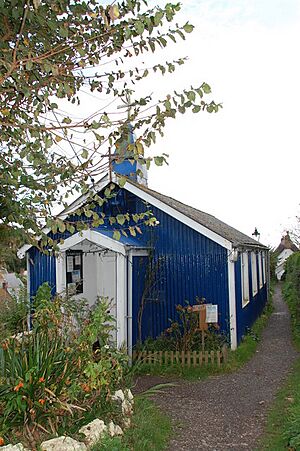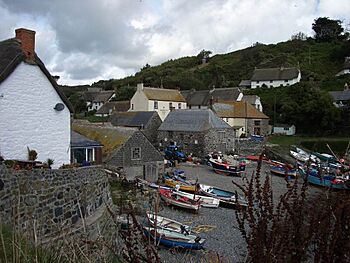Cadgwith facts for kids
Quick facts for kids Cadgwith
|
|
|---|---|
 |
|
| Lua error in Module:Location_map at line 530: Unable to find the specified location map definition: "Module:Location map/data/Cornwall (mainland)" does not exist. | |
| OS grid reference | SW721146 |
| Civil parish |
|
| Unitary authority | |
| Ceremonial county | |
| Region | |
| Country | England |
| Sovereign state | United Kingdom |
| Post town | HELSTON |
| Postcode district | TR12 |
| Dialling code | 01326 |
| Police | Devon and Cornwall |
| Fire | Cornwall |
| Ambulance | South Western |
| EU Parliament | South West England |
| UK Parliament |
|
Cadgwith (Cornish: Porthkajwydh, meaning cove of the thicket) is a small village and fishing port in Cornwall, England. It is found on the Lizard Peninsula, a famous area known for its beautiful coastline. The village is located between the villages of The Lizard and Coverack. It is part of the civil parish of Grade Ruan.
Contents
A Look Back in Time: Cadgwith's History
Cadgwith started a very long time ago, in the medieval period. It began as a group of buildings called fish cellars. These were built in a sheltered valley right by the sea. The valley had a shingle (small stones) cove. Fishing helped local farmers earn extra money.
The village's original name was 'Porthcaswydh'. This name comes from the Cornish language word for 'a thicket', which means a dense group of bushes or trees. It probably got this name because the valley was once full of trees.
From the 1500s, people started living in the village. Fishing became the main job. Houses, storage buildings, and cellars were built along the beach. They were made from local stone or cob (a mix of clay, sand, straw, and water). Their roofs were either thatched (made of straw) or slated. This is how Cadgwith got its classic Cornish fishing village look.
More recently, a small Anglican church was built. It is next to the path that leads from the car park to the seafront. This church is dedicated to St Mary. It is known as a 'tin tabernacle' because it was built with corrugated iron. In February 2024, this church was given a special status as a Grade II listed building. This means it is an important historic building.
Exploring Cadgwith's Geography
Cadgwith has two beaches. A rocky point called "The Todden" separates them. "Todden" is thought to mean 'laying ground' in Cornish.
The larger beach is to the north-east. It is mostly made of shingle and slopes gently. People call it Cadgwith Cove, Big Beach, The Cove, Fishing Beach, or the Working Cove. All the local fishermen use this beach for their work.
The other beach is smaller and on the south-west side. It has a mix of sand and large rocks. This beach is called Little Cove, Cadgwith Cove, or Little Beach. Locals and visitors use it for swimming.
The Todden is about 9 meters (30 feet) high. It offers great views of the beaches and the village. There is a natural passage through The Todden that connects the two beaches. Out in the sea from The Todden are two rocks called The Island and The Mare. When the tide is low, you can walk between the Todden and The Island.
Cadgwith is protected from strong winds that usually come from the south-west or west. However, winds from the east or south-east can make the sea rough. During storms, waves can even break over The Island. Sometimes, rough seas can reach the buildings and homes closest to the water. The sea has worn away parts of The Todden. Sea walls have been built to protect the narrow path to the rocky point. These walls were paid for by Cornwall Council and The Tham Trust.
Cadgwith is also part of the Cornwall Area of Outstanding Natural Beauty (AONB). This means the area has special natural beauty that is protected.
Fishing Life in Cadgwith
Cadgwith exists because of its fishing industry. For many years, until the 1950s, people fished for pilchards. They used large seine boats and nets. These nets were used to catch huge groups of pilchards. Lookouts called huers (from the Cornish 'Hevva, Hevva!' meaning 'Here they are!') helped coordinate the fishing. They stood on the two headlands (cliffs) above the cove. In 1904, a record 1,798,000 pilchards were caught in just four days!
Today, pilchards are not found in large enough numbers for fishing in Cadgwith. This is due to too much fishing in the past and changes in the climate. Instead, fishermen now catch brown edible crabs, spider crabs, lobsters, sharks, monkfish, and conger eel. Most of these are sold to other countries through fish merchants. However, some are sold locally by the fishmonger, café, pub, and seafood snack shop. You can still see the Huer's hut on the cliff above the beach.
Shipwrecks Near Cadgwith
The Lizard Peninsula coastline is very dangerous. This is because of hidden rocks and bad weather like gales, storms, or fog. Many ships have been wrecked on the rocks near Lizard Point, known as The Stags. There are also many wrecks at The Manacles, which are near Coverack. Off the coast of Cadgwith, there are other rocks called The Craggan and The Boa. Deep sea diving to explore these wrecks is a popular activity.
The Brave Lifeboats of Cadgwith
Lifeboat services in the British Isles are run by a charity called the Royal National Lifeboat Institution (RNLI). These services are staffed by brave volunteers.
The RNLI had a lifeboat station in Cadgwith from 1867 to 1963. Local fishermen volunteered to be the lifeboat crew. They helped all sailors in trouble, especially because the local waters were so dangerous. Until 1941, the station used a boat that was rowed and sailed. In 1941, a motor lifeboat called Guide of Dunkirk arrived.
The Cadgwith station closed in 1963. This happened after the Lizard and Cadgwith lifeboat services joined together in 1961. A new lifeboat station, the Lizard-Cadgwith Lifeboat Station, opened at Kilcobben Cove. This new location is about halfway between The Lizard and Cadgwith. It is also more protected from strong winds. In 1987, the name changed to the Lizard Lifeboat. In 2012, the boathouse was rebuilt to hold a new, modern lifeboat. The old lifeboat house in Cadgwith is now used by the Cadgwith Pilot Gig Club.
Famous Cadgwith Lifeboats
The first lifeboat was named Western Commercial Traveller. It was about 10 meters (33 feet) long and 2.4 meters (8 feet) wide. It had a crew of thirteen and was rowed by ten oars. It cost £290. In 1878, this boat was renamed Joseph Armstrong.
A new lifeboat, also named Joseph Armstrong, arrived in June 1887. This one was about 11 meters (37 feet) long and 2.4 meters (8 feet) wide. It had twelve oars and fifteen crew members. It cost £454.
In 1898, a new lifeboat called Minnie Moon came to Cadgwith. She was about 12 meters (39 feet) long and 2.9 meters (9 feet 6 inches) wide. She had twelve oars and fifteen crew. She cost £798. The Minnie Moon holds a record for saving the most lives in one rescue. She saved 227 lives from the SS Suevic on March 17/18, 1907. The Suevic was wrecked in fog and gales on The Stag Rocks near Lizard Point. Two silver RNLI gallantry medals were given to members of the Cadgwith crew for their bravery. Other lifeboat crews from The Lizard, Coverack, and Porthleven also helped in this rescue. The 100-year anniversary of this amazing rescue was celebrated on March 17, 2007.
The Herbert Sturmey arrived in 1932. She was about 11 meters (37 feet) long and 2.8 meters (9 feet 3 inches) wide. She had twelve oars and fifteen crew. She cost £2000.
The last Cadgwith lifeboat was the Guide of Dunkirk. She was named this because money for her was raised by the Girl Guides of the Empire. She was originally meant for the Cromer station. However, she took part in the Dunkirk evacuations in 1940, where she got bullet holes and other damage. She was about 10.7 meters (35 feet) long and 2.9 meters (9 feet 6 inches) wide. She was the only Cadgwith lifeboat to have an engine and had a crew of seven. She cost £5523. Today, you can see her on display at Mevagissey.
Fun for Visitors: Tourism in Cadgwith
Today, tourism is the main way people in Cadgwith earn money. This is because the fishing industry has become smaller. Many houses in the village are now rented out as holiday homes.
Cadgwith has always been a popular holiday spot, especially in the summer. There are many local events during this time. These include gig racing days, summer barbecues, and a regatta (boat race). You can also see Morris dancing, listen to musical bands, and enjoy regular singing by the Cadgwith Singers at the local pub. The pub, called the Cadgwith Cove Inn, is thought to be over 400 years old!
The South West Coast Path goes right through the village. Many walkers stop here to rest and get refreshments. A local fisherman runs a fishmonger's shop. Here you can buy fresh fish and even get recipes. There is also a local craft shop.
If you walk along the coast path towards The Lizard, you will find an interesting natural feature. It is called The Devil's Frying Pan. This is a cave whose roof collapsed, leaving its entrance like a bridge. The bay inside is full of boulders. During rough weather, the water in the bay looks like it is 'boiling'.




